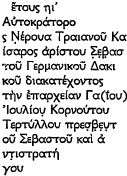No CrossRef data available.
Article contents
A New Text from Asia Minor
Published online by Cambridge University Press: 28 February 2013
Extract
By courtesy of the owner, I publish a standard weight found in Asia Minor and now in the Collection Breusch. It is a hexagonal plaque of lead, pierced at one angle for suspension by a cord, of maximum width 0·16 m. and weight 2·6 kg. Both faces are inscribed with letters in relief, within a raised border. On face (a) the letters are above and on either side of a relief showing the bust of a curly-headed man facing right and carrying a caduceus over his left shoulder—certainly Hermes Agoraios, patron of the market-place. The inscription on face (b) is upside down to that on face (a).
Face (a). Letters, c. 0·012;  (See Plate I.)
(See Plate I.)

The final  is badly formed and looks more like
is badly formed and looks more like 

- Type
- Research Article
- Information
- Copyright
- Copyright © The Author(s). Published online by Cambridge University Press 1963
References
1 It is not at present accessible; description and details are taken from the photographs and the owner's notes.
2 For the shape cf. the hexagonal weight from Laodicea by the Sea, Seyrig, H., ‘Poids antiques de la Syrie et de la Phénicie’, Bulletin du Musée de Beyrouth, VIII (1948), 39f.Google Scholar, Laodicea no. 35. For the suspension hole cf. Walters, H. B., Catalogue of the Bronzes, Greek, Roman and Etruscan, in the Department of Greek and Roman Antiquities, British Museum (London, 1899), no. 2998.Google Scholar
3 See Roscher, 's Myth. Lex. vol. 1, col. 2381 f.Google Scholar For Hermes on weights cf. the example at Istria, Preda, C., Dacia, n.s. II (1958), 451 f.Google Scholar, to which town Preda also attributes examples previously published as from Tomi. There are also a number of instances of the caduceus alone, as at Antioch on the Orontes, Seyrig, loc. cit., Antioch no. 5.


